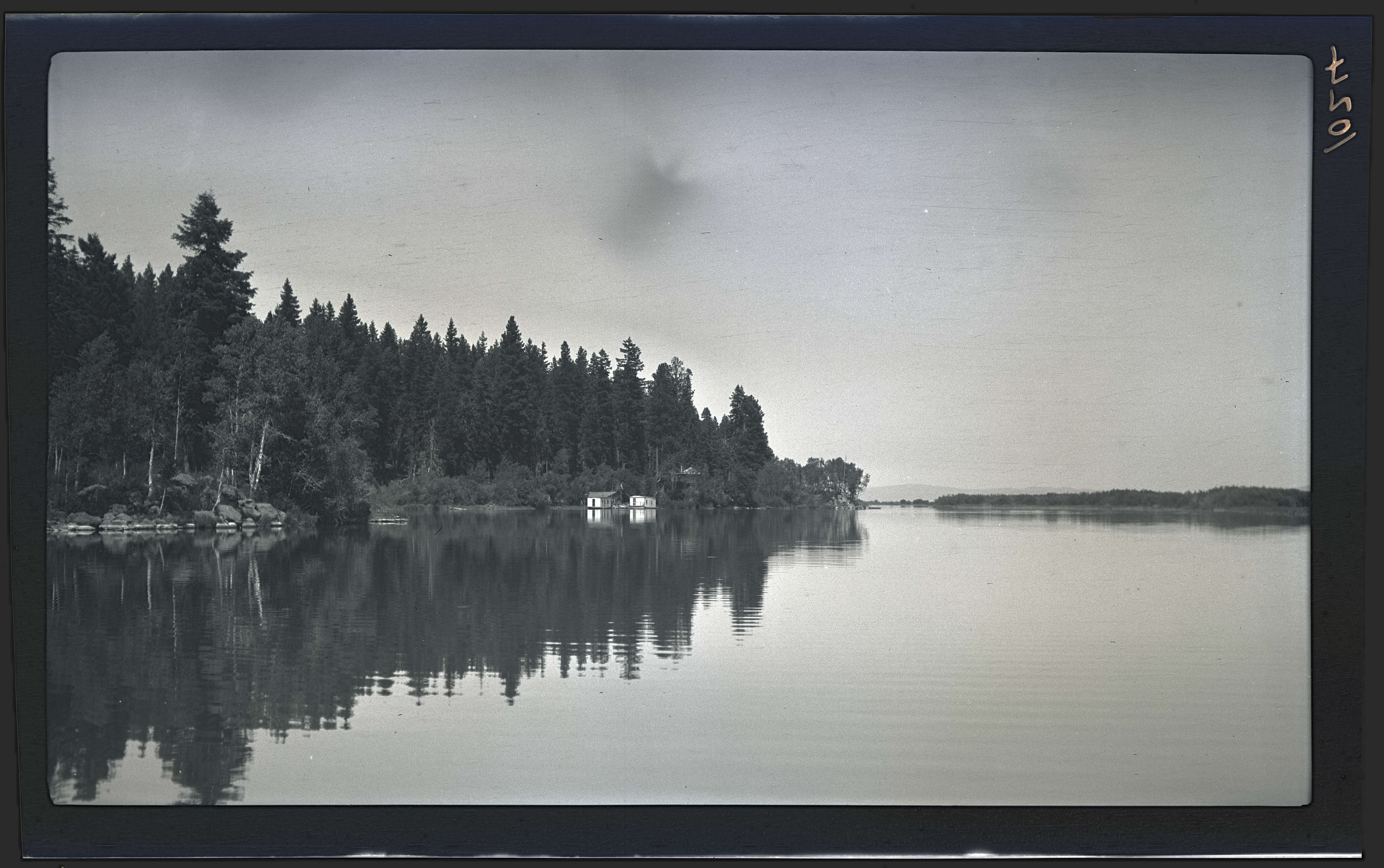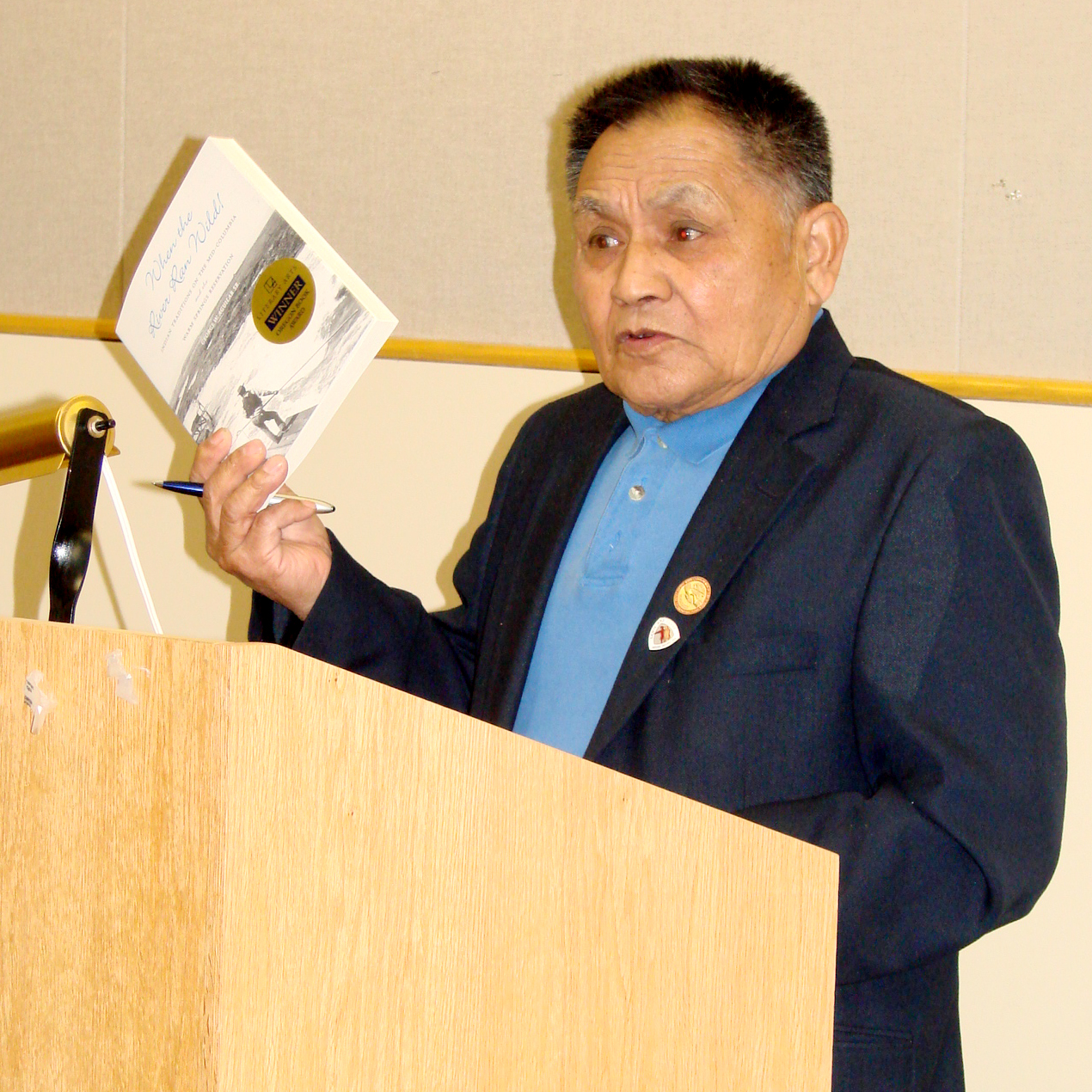
Indigenous Peoples' Day
On this land we are all motion.
We age. Society changes. New people arrive. Old people leave. Memory stays.
Elizabeth Woody, Oregon Poet Laureate
From "Recognition of the Maker," 2000
 Tsin-is-tum stands in front of an Indian Place house; the woman seated is likely De-o-so, wife of Chief Kotata.
Tsin-is-tum stands in front of an Indian Place house; the woman seated is likely De-o-so, wife of Chief Kotata.
Urban Indians, by Claudia Welala Long (Nez Perce)
The Portland Metro area rests on traditional village sites of Native peoples. These include those of Chinookan-speaking (or Kiksht-speaking) peoples, such as the Multnomah, Cascade, Clackamas, and Clowwewalla, who made their homes along the Columbia and Willamette Rivers, creating communities and summer encampments in areas rich in natural resources. The Tualatin Kalapuya were the ancestral people in present-day Washington County, and their homelands include portions of West Portland and the towns of Hillsboro, Forest Grove, Beaverton, and Tigard. The traditional homelands of the Molalla people of the northeast Willamette Valley and Cascade Range include areas as far north as Oregon City. In the twenty-first century, Native American residents of urban areas include people from across the region and the larger United States. Enrolled members of Northwest tribes who live in urban areas often have ancestral treaty rights to fish and gather along riverways. Some citizens or descendants of Indigenous people represent degrees of tribal affiliation; some are enrolled, some are not, but all have significant ancestral ties to their tribes and tribal homelands.
“‘Urban’ is not a kind of Indian,” Terry Straus and Debra Valentino (Oneida) wrote. “It is an experience, one that most Indian people today have had.” For generations, many Indigenous people have lived away from their tribal homelands, and Urban Indians from all over the United States are residents of Oregon. Approximately 40,000 Urban Indians live in Portland, the ninth largest such community in the United States, and others live in all thirty-six counties.
 Students and staff on Chemawa grounds, 1887
Students and staff on Chemawa grounds, 1887
Thomas J. Cronise and the Chemawa Indian Boarding School photographs
As early as 1904, Tom Cronise had begun marketing his portrait photography for $0.50 a photo to people who attended classes and lived at Chemawa Indian Boarding School, north of Salem. He took hundreds of photographs of people at Chemawa and in the Salem area, and the Oregon Historical Society holds many of the original negatives. For more of the Cronise Chemewa collection, click here.
-
![]()
William J. Church (far left) and friends, 1917.
-
![]()
Students and staff on Chemawa grounds, 1887.
-
![]()
Theresa Gua, 1918.
-
![]()
Steven Chiefnight, 1917.
-
![]()
Minnie Columbia, 1917.
-
![]()
Paul Liphart, 1919.
-
![]()
Mary Liphart and family, 1906.
-
![]()
Maggie Johnson, 1913.
-
![]()
Maggie Allard, 1914.
-
![]()
Madrona Mann, 1917.
-
![]()
Isaac Medicien, 1918.
-
![]()
Irene Matt, with friend, 1918.
-
![]()
Frank Evans, 1922.
-
![]()
Edna Hill, 1919.
-
![]()
Catherine Matte, 1917.
-
![]()
Bessie Chiloquin, 1905.
-
![]()
Anna McKinck, 1918.
-
![]()
Alpheus Dalton, 1917.
On The OE
-
![Apserkahar (Chief Joe)]()
Apserkahar (Chief Joe)
In the 1850s, Apserkahar, also known as Chief Joe, led one of the two p…
-
![Coyote (legend)]()
Coyote (legend)
The figure of Coyote is prominent in Native American traditional narrat…
-
![David Sohappy (1925–1991)]()
David Sohappy (1925–1991)
Born and raised on the Yakama reservation in south-central Washington a…
-
![Edison Chiloquin (1923-2003)]()
Edison Chiloquin (1923-2003)
Edison Chiloquin earned international attention in 1974 when he refused…
-
![Elizabeth Woody (1959-)]()
Elizabeth Woody (1959-)
Poet and artist Elizabeth Woody was named Oregon Poet Laureate in 2016,…
-
![George W. Aguilar, Sr. (1930-)]()
George W. Aguilar, Sr. (1930-)
George W. Aguilar, Sr., is a Wasco Elder and life-long resident of the …
-
![Gloria Bird (1951-)]()
Gloria Bird (1951-)
Through both her creative and academic work, Gloria Bird helped establi…
-
![Halito (Chief Halo) (?-1892)]()
Halito (Chief Halo) (?-1892)
Chief Halito, commonly shortened to Chief Halo (meaning “having little”…
-
![Heinmot Tooyalakekt (Chief Joseph) (1840-1904)]()
Heinmot Tooyalakekt (Chief Joseph) (1840-1904)
Heinmot Tooyalakekt (Thunder Rising to Loftier Mountain Heights), also …
-
![Henry Yelkus (c. 1843–1913)]()
Henry Yelkus (c. 1843–1913)
Henry Yelkus (also spelled Yalkus, Yelkes, Yelkis, Yal-kus, and Yelcus)…
-
![Jean Baptiste Charbonneau (1805-1866)]()
Jean Baptiste Charbonneau (1805-1866)
Jean Baptiste Charbonneau is remembered primarily as the son of Sacagaw…
-
![Jim Pepper (1941-1992)]()
Jim Pepper (1941-1992)
Tenor saxophonist Jim Pepper was an internationally recognized and infl…
-
![Kalliah Tumulth (Indian Mary) (1854-1906)]()
Kalliah Tumulth (Indian Mary) (1854-1906)
Kalliah Tumulth, also called Indian Mary, was a Cascade (Watlala) Chino…
-
![Kathryn Harrison (1924-2023)]()
Kathryn Harrison (1924-2023)
Kathryn Jones Harrison of the Confederated Tribes of Grand Ronde was on…
-
![Kiesno (Chief Cassino) (1779?-1848)]()
Kiesno (Chief Cassino) (1779?-1848)
Chief Kiesno (his name has also been spelled Keasno, Casino, Kiyasnu, Q…
-
![Kintpuash (Captain Jack) (c. 1837-1873)]()
Kintpuash (Captain Jack) (c. 1837-1873)
Kintpuash (Strikes the Water Brashly), also known as Captain Jack an…
-
![Lillian Pitt (1944-)]()
Lillian Pitt (1944-)
Lillian Pitt (Warm Springs, Wasco, and Yakama) was born on the Warm Spr…
-
![Marie Dorion (1790?–1850)]()
Marie Dorion (1790?–1850)
A woman of Sioux and, more particularly, Iowa descent, Marie Dorion, by…
-
![Peter Kenoyer (c. 1835–1886) and Louis Kenoyer (1868–1937)]()
Peter Kenoyer (c. 1835–1886) and Louis Kenoyer (1868–1937)
It is to Peter Kenoyer (Kinai [kʼiˈnɑ:i]) and his son Louis Kenoyer (Ba…
-
![Reuben C. Sanders (1876–1957)]()
Reuben C. Sanders (1876–1957)
Reuben “Reub” C. Sanders was one of Oregon’s greatest all-around athlet…
-
![Sacagawea]()
Sacagawea
Sacagawea was a member of the Agaideka (Lemhi) Shoshone, who lived in t…
-
![Sarah Winnemucca (1844?-1891)]()
Sarah Winnemucca (1844?-1891)
Sarah Winnemucca, a Paiute, had a clear purpose in life: “I mean to fig…
-
![Silas Bryant Smith (1839-1902)]()
Silas Bryant Smith (1839-1902)
Silas Bryant Smith played a key role in recording the traditions, relig…
-
![Tecumtum (?-1864)]()
Tecumtum (?-1864)
Tecumtum, whose name means Elk Killer, was the principal chief of the E…
-
![Urban Indians in Oregon]()
Urban Indians in Oregon
The Portland Metro area rests on traditional village sites of Native pe…
-
![Victoria (Wishikin) Wacheno Howard (c. 1865-1930)]()
Victoria (Wishikin) Wacheno Howard (c. 1865-1930)
Victoria (Wishikin) Wacheno Howard was the teller of Clackamas Chinook …
-
![Winona LaDuke (1959-)]()
Winona LaDuke (1959-)
Winona LaDuke (Mississippi Band of Anishinaabe Indians) is an internati…












































